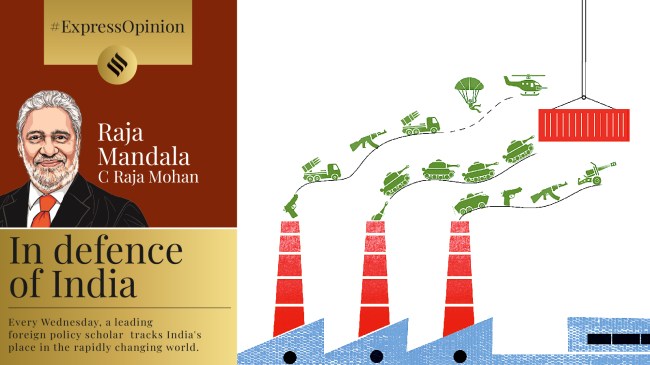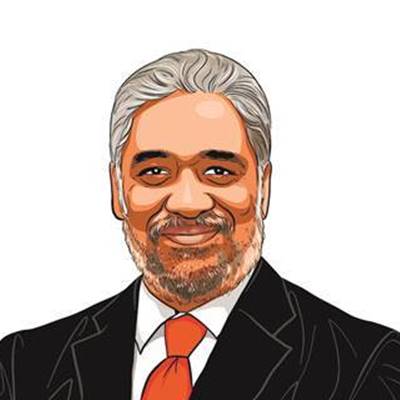Opinion C Raja Mohan writes: Dealing with the China question
India will need to move much faster on the reform front than it has so far to cope with the massive gap in the defence capabilities with China as well as seize the international opportunity for the transformation of its defence industrial base.
 India has talked of a greater role for the Indian private sector in defence production and has put special emphasis on arms exports. A high-level committee of the government has also recommended the reorganisation of the Defence Research and Development Organisation. (Illustration by C R Sasikumar)
India has talked of a greater role for the Indian private sector in defence production and has put special emphasis on arms exports. A high-level committee of the government has also recommended the reorganisation of the Defence Research and Development Organisation. (Illustration by C R Sasikumar) Two recent defence agreements, highlighted during Defence Minister Rajnath Singh’s visit to a Southeast Asian defence ministerial forum in Laos, point to the many untapped possibilities for developing India’s security cooperation with like-minded Asian countries. Building defence networks with Asian friends is an urgent imperative for India amid China’s growing military capabilities and the urgent need for modernisation of India’s defence industrial base.
 The agreement with Australia facilitates air-to-air refuelling between Indian and Australian military aircraft. This will extend the reach of both air forces and promote their interoperability. In his consultations with his Japanese counterpart, Rajnath Singh continued recent conversations with Tokyo on defence industrial collaboration. A few days earlier, Delhi and Tokyo signed a Memorandum of Understanding (MoU) on joint production of stealth equipment for Indian warships. Though limited in scope, these agreements point to the direction India and its Asian partners must travel, given their shared interests in the regional security order.
The agreement with Australia facilitates air-to-air refuelling between Indian and Australian military aircraft. This will extend the reach of both air forces and promote their interoperability. In his consultations with his Japanese counterpart, Rajnath Singh continued recent conversations with Tokyo on defence industrial collaboration. A few days earlier, Delhi and Tokyo signed a Memorandum of Understanding (MoU) on joint production of stealth equipment for Indian warships. Though limited in scope, these agreements point to the direction India and its Asian partners must travel, given their shared interests in the regional security order.One key concern is Chinese assertiveness on territorial disputes in the region. To be sure, Beijing is turning on its charm diplomacy these days after years of muscular unilateralism on disputed frontiers with its neighbours, including India, and intense “wolf-warrior” diplomacy. Sceptics remind us that China’s mood could easily swing the other way at any time.
What matters more than Beijing’s current positive diplomatic posture is the nature of Chinese military capability. Current intentions must always be viewed in the context of China’s military weight on the ground. Its defence expenditure overshadows that of its neighbours, including India and Japan, combined.
Beijing’s defence production has reached formidable proportions, thanks to China’s expansive industrial infrastructure, impressive military modernisation over the last three decades, and massive investments in defence research and development. Consider this example: China commissioned 70 submarines between 1995 and 2020 — nearly three a year. This scale of military production hasn’t been seen since the height of the Second World War.
No Chinese neighbour, including major powers like India, can cope alone with the rapidly widening gap between their defence capabilities and Beijing’s. This explains why China’s Asian neighbours have been open to greater security cooperation with the United States over the last decade. For most, including Delhi, it’s clear that stabilising the Asian balance of power requires America’s presence.
There was a time when the region believed in “Asia for Asians” and saw no reason for “external powers” to maintain their military presence. China still plays on this sentiment, arguing that “outsiders” shouldn’t meddle in its disputes with Asian neighbours. Few in Asia today accept this “Asia for Asians” rhetoric, though not all express this openly for fear of offending Beijing. Many of them can see that the slogan of “Asia for Asians” is about consolidating Chinese primacy over the region.
In fact, China’s assertiveness has produced strong regional support for American armed forces in Asia. It’s also Washington’s fear of Beijing replacing it as Asia’s dominant power that drives increased US strategic attention to the region.
The question isn’t about the political legitimacy of American military presence in Asia, but rather its intensity and sustainability. Unlike earlier, the US no longer enjoys overwhelming military dominance in the East Asian theatre. China’s People’s Liberation Army (PLA) is eroding that dominance on a daily basis. Though US armed forces and weaponry remain qualitatively superior, the PLA’s quantitative advantage is beginning to shift the regional balance.
Another challenge is America’s involvement in multiple theatres. While China can focus its military resources on its immediate Asian neighbourhood, the US must spread its forces across Europe, the Middle East, and Asia. Hopes of reducing US commitments to Europe and the Middle East to focus on Asia have diminished significantly in recent years.
America’s NATO commitments have proven enduring due to the collapse of post-Cold War security arrangements in Europe and Russia’s 2022 invasion of Ukraine. Similarly persistent is American involvement in the Middle East. The October 7, 2023, terror attacks on Israel and Tel Aviv’s ongoing war against Gaza and Lebanon have pulled the US back into the region. While some in Washington claim the US can fight on all three fronts, sceptics highlight the growing challenges of effective operations across these theatres.
A major US military constraint is its inability to meet weapons demands — ammunition, missiles, or drones — for ongoing conflicts in Europe and the Middle East. The renowned American military-industrial complex can’t mass-produce weapons to meet current demands, let alone prepare for a potential conflict with China in Asia.
Many American military production facilities are outdated, and the US defence industry lacks skilled personnel. As it works to revamp its defence industry, the US is turning to allies and partners. Washington, for instance, is negotiating collaboration with Japanese and Korean shipyards to regain maritime competitiveness against China. Policy makers in Tokyo and Seoul have problems of their own — a declining population and an ageing workforce.
The reshaping of global defence supply chains amid growing military challenges is also urgent for Europe, which struggles to meet the war material needs of Ukraine. This new international situation presents an opportunity to accelerate the modernisation of India’s defence production system. Delhi has signed defence industrial roadmaps with the United States and France and plans to negotiate with Italy. India has talked of a greater role for the Indian private sector in defence production and has put special emphasis on arms exports. A high-level committee of the government has also recommended the reorganisation of the Defence Research and Development Organisation. India has also stepped up its military diplomacy in the region and beyond.
India will need to move much faster on the reform front than it has so far to cope with the massive gap in the defence capabilities with China as well as seize the international opportunity for the transformation of its defence industrial base.
The writer is contributing editor on international affairs for The Indian Express






